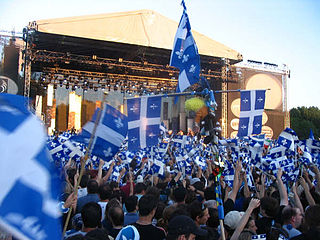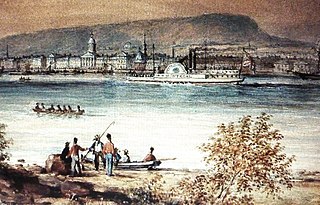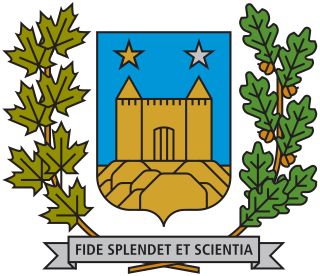
Quebec nationalism or Québécois nationalism is a feeling and a political doctrine that prioritizes cultural belonging to, the defence of the interests of, and the recognition of the political legitimacy of the Québécois nation, particularly its French Canadian population. It has been a movement and a central issue in Quebec politics since the beginning of the 19th century. Québécois nationalism has seen several political, ideological and partisan variations and incarnations over the years.

HEC Montréal is a bilingual public business school located in Montreal, Quebec, Canada. Founded in 1907, HEC Montréal is the graduate business school of the Université de Montréal and is the first established school of management in Canada.

The culture of Quebec emerged over the last few hundred years, resulting predominantly from the shared history of the French-speaking North American majority in Quebec. Québécois culture, as a whole, constitutes all distinctive traits – spiritual, material, intellectual and affective – that characterize Québécois society. This term encompasses the arts, literature, institutions and traditions created by Québécois, as well as the collective beliefs, values and lifestyle of Québécois. It is a culture of the Western World.

The architecture of Montreal, Quebec, Canada is characterized by the juxtaposition of the old and the new and a wide variety of architectural styles, the legacy of two successive colonizations by the French, the British, and the close presence of modern architecture to the south. Much like Quebec City, the city of Montreal had fortifications, but they were destroyed between 1804 and 1817.

Montreal was established in 1642 in what is now the province of Quebec, Canada. At the time of European contact the area was inhabited by the St. Lawrence Iroquoians, a discrete and distinct group of Iroquoian-speaking indigenous people. They spoke Laurentian. Jacques Cartier became the first European to reach the area now known as Montreal in 1535 when he entered the village of Hochelaga on the Island of Montreal while in search of a passage to Asia during the Age of Exploration. Seventy years later, Samuel de Champlain unsuccessfully tried to create a fur trading post but the Mohawk of the Iroquois defended what they had been using as their hunting grounds.
Pointe-Saint-Charles is a neighbourhood in the borough of Le Sud-Ouest in the city of Montreal, Quebec, Canada. Historically a working-class area, the creation of many new housing units, the recycling of industrial buildings into business incubators, lofts, and condos, the 2002 re-opening of the canal as a recreation and tourism area, the improvement of public spaces, and heritage enhancement have all helped transform the neighbourhood and attract new residents. Community groups continue to be pro-active in areas related to the fight against poverty and the improvement of living conditions.

The Sun Life Building is a historic 122-metre (400 ft), 24-storey office building at 1155 Metcalfe Street on Dorchester Square in the city's downtown core of Montreal, Quebec, Canada.
The Quebec School of Evangelical Theology (ETEQ) is an interdenominational Evangelical bible college in Montreal, Canada.

Montreal's New York Life Insurance Building is an office building at Place d'Armes in what is now known as Old Montreal, erected in 1887–1889. At the time of its completion, it was the tallest commercial building in Montreal with the first eight floors were designed for retail office space, that quickly filled with the city's best lawyers and financiers. When the clock tower was completed, the owner filled the ninth and tenth floors with the largest legal library in the entire country as a gift to tenants. The building is next to another historic office tower, Aldred Building.

The Parliament Building of Quebec is an eight-floor structure and is home to the National Assembly of Quebec, in Quebec City, Quebec, Canada. The Parliament Building was designed by architect Eugène-Étienne Taché in a Second Empire style and built between 1877 and 1886, in the heart of Quebec's Parliament Hill. The National Assembly first met there on March 27, 1884, even though the building was only fully completed two years later, on April 8, 1886. From the 1910s to the 1930s, the government built several adjacent buildings to expand its office spaces, creating a parliamentary complex, of which the Parliament Building is the main edifice. This structure is a successor of several earlier buildings, the earliest of which was built in 1620 and among which there were two other parliament houses that served as legislatures.

Montreal is the largest city in the province of Quebec, the second-largest in Canada, and the ninth-largest in North America. Founded in 1642 as Ville-Marie, or "City of Mary", it is now named after Mount Royal, the triple-peaked mountain around which the early settlement was built. The city is centred on the Island of Montreal and a few, much smaller, peripheral islands, the largest of which is Île Bizard. The city is 196 km (122 mi) east of the national capital, Ottawa, and 258 km (160 mi) southwest of the provincial capital, Quebec City.

The Université de Montréal is a French-language public research university in Montreal, Quebec, Canada. The university's main campus is located in the Côte-des-Neiges neighborhood of Côte-des-Neiges–Notre-Dame-de-Grâce on Mount Royal near the Outremont Summit, in the borough of Outremont. The institution comprises thirteen faculties, more than sixty departments and two affiliated schools: the Polytechnique Montréal and HEC Montréal. It offers more than 650 undergraduate programmes and graduate programmes, including 71 doctoral programmes.

François Dollier de Casson was born in France into a wealthy bourgeois and military family. He began his adult life in the army which he left after three years to continue his studies and become a priest.

Tourism is the fifth-largest industry in Quebec. Some 29,000 companies are involved in the industry, generating 130,000 direct and 48,000 indirect jobs. In 2006, Quebec welcomed 3.2 million foreign tourists, most of them from the United States, France, the United Kingdom, Germany, Mexico and Japan.

The architecture of Quebec, was characterized in the beginning by the settlers of the rural areas along the St. Lawrence who largely came from Normandy. The houses they built echoed their roots. The surroundings forced enough differences that a unique style developed, and the house of the New France farmer remains a symbol of French-Canadian nationalism. These were rectangular structures of one storey, but with an extremely tall and steep roof, sometimes almost twice as tall as the house below. This roof design perhaps developed to prevent the accumulation of snow. The houses were usually built of wood, though the surviving ones are almost all built of stone. Landmarks in the rural areas were the churches and the mansion of the seigneurs. The seigneurs built much larger homes for themselves, but rarely were the manors ornate. Each parish had its church, often smelter copies of major churches in Quebec City or Montreal. A unique style of French-Canadian homo church thus developed.

Metcalfe Street is a north–south street located in downtown Montreal, Quebec, Canada. It links Sherbrooke Street in the north and René Lévesque Boulevard in the south. It is best known for being the street on which the Sun Life Building, Mary, Queen of the World Cathedral, and other notable buildings are located. South of René Lévesque Boulevard, the street is known as Cathedral Street. The street borders the eastern side of both Dorchester Square and Place du Canada, to the south.

Dorchester Square, originally Dominion Square, is a large urban square in downtown Montreal. Together with Place du Canada, the area is just over 21,000 m2 (230,000 sq ft) or 2.1 ha of manicured and protected urban parkland bordered by René Lévesque Boulevard to the south, Peel Street to the west, Metcalfe Street to the east and Dorchester Square Street to the north. The square is open to the public 24 hours a day and forms a focal point for pedestrian traffic in the city. Until the creation of Place du Canada in 1967, the name "Dominion Square" had been applied to the entire area.

Cité du Havre is a neighbourhood in the borough of Ville-Marie of the city of Montreal, Quebec, Canada. It is located on a narrow man-made peninsula, the Mackay Pier, which was largely built to protect the Old Port of Montreal from the currents of the Saint Lawrence River and from ice banks and floodings in the springtime.

Carcasses is a Canadian docufiction film, directed by Denis Côté and released in 2009. Blending documentary and fictionalized elements, the film is a portrait of Jean-Paul Colmor, a real-life man who runs a scrapyard of old broken-down cars, with a cast consisting almost entirely of non-professional actors.
The following is a timeline of the COVID-19 pandemic in the province of Quebec.


















